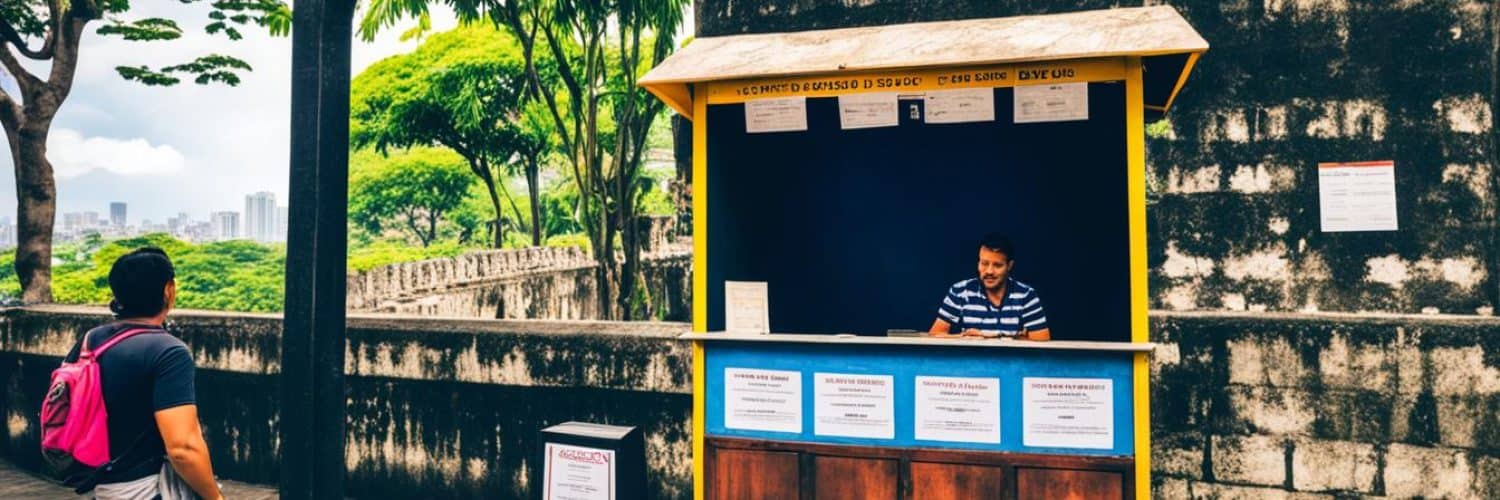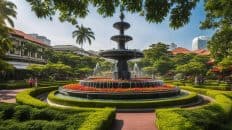Are you ready to immerse yourself in the rich history of Manila? Look no further than Fort Santiago in Intramuros, where you can step back in time and explore one of the oldest fortifications in the city. By purchasing a Fort Santiago ticket, you can unlock the doors to a world of historical significance and cultural heritage.
Key Takeaways:
- Fort Santiago is one of the oldest fortifications in Manila, built in 1571 by the Spaniards.
- By purchasing a Fort Santiago ticket, visitors can explore the fort and learn about its historical significance.
- Fort Santiago served as a strategic location for various occupation forces throughout the years.
- Today, it stands as a memorial to the victims of World War II and a reminder of the Filipino people’s pursuit of freedom.
- Plan your visit in advance and take advantage of the best ticket deals to fully experience the charm of Fort Santiago in Intramuros, Manila.
Overview of Fort Santiago
Fort Santiago, located in Intramuros Manila, is a historical site that holds significant cultural and architectural value. Originally built as a wooden structure by Rajah Soliman, it was later reconstructed using stone in the late 16th century. Throughout history, the fort has served as a headquarters for various occupation forces, including the Spanish, British, American, and Japanese.
The fort played a crucial role in the defense of Manila and witnessed significant events during the Battle of Manila in 1945. Although heavily damaged, Fort Santiago was restored and recognized as a Shrine of Freedom in 1950. Today, it stands as a testament to the resilience and determination of the Filipino people.
Fort Santiago attracts visitors from all over the world who are drawn to its historical significance and stunning architecture. Exploring the fort offers a unique opportunity to delve into the country’s rich past and witness the layers of history that have shaped the Philippines.
At Fort Santiago, visitors can admire the fusion of Spanish and Filipino influences in its design, as well as explore the various attractions within its walls. From the Ticket Booth and Intramuros Visitors Center to the Baluartillo de San Francisco Javier and the Reducto de San Francisco Javier, each site offers a glimpse into the fort’s intriguing past. Whether wandering through the Ruins of the American Barracks or contemplating the Wall of Martyrs, there is something for everyone to discover at Fort Santiago.
With its storied history and captivating charm, Fort Santiago stands as a must-visit attraction within the vibrant city of Intramuros, Manila. The fort invites visitors to immerse themselves in Philippine history, explore its architectural highlights, and gain a deeper appreciation for the country’s cultural heritage.
Key Highlights of Fort Santiago:
- Construction by Rajah Soliman
- Stone reconstruction in the late 16th century
- Headquarters for Spanish, British, American, and Japanese forces
- Significant role in the Battle of Manila
- Restoration and declaration as a Shrine of Freedom
- Architectural fusion of Spanish and Filipino influences
- Attractions like the Ruins of the American Barracks and the Wall of Martyrs
What to Expect at Fort Santiago
When visiting Fort Santiago, visitors can expect to see various attractions within its walls. These include:
- The Ticket Booth
- The Intramuros Visitors Center
- The Almacenes Reales
- Plaza Moriones
- The Baluartillo de San Francisco Javier
- The Reducto de San Francisco Javier
- The Ruins of the American Barracks
- The Wall of Martyrs
- The Rajah Soliman Mural
- The Bamboo Garden
- The Moat
- The Fort Santiago Gate
- The Baluarte de San Miguel
Each attraction offers a unique glimpse into the fort’s history and significance. Visitors can explore the Ticket Booth for information and purchasing tickets, the Intramuros Visitors Center to learn more about Intramuros and Fort Santiago, and the Almacenes Reales to discover the former royal warehouses and their historical artifacts. Plaza Moriones provides a serene open space, perfect for taking a break and admiring the surroundings.
The Baluartillo de San Francisco Javier and the Reducto de San Francisco Javier are ancient bastions that once defended the fort from attacks. The Ruins of the American Barracks showcase the remnants of American military structures, offering insight into the fort’s role during the American occupation.
The Wall of Martyrs stands as a memorial to the brave Filipino soldiers and civilian martyrs who fought during the Battle of Manila. The Rajah Soliman Mural depicts the indigenous history of Intramuros and the Philippines. The Bamboo Garden offers a peaceful oasis within the fort, while the Moat provides a picturesque view and a glimpse of the fort’s defensive system.
The Fort Santiago Gate is a grand entrance that welcomes visitors to the fort, while the Baluarte de San Miguel showcases the fort’s iconic circular bastion, featuring breathtaking views of Manila.
Highlights of Fort Santiago Attractions
| Attraction | Description |
|---|---|
| Ticket Booth | Information and ticketing center |
| Intramuros Visitors Center | Provides insights into Intramuros and Fort Santiago |
| Almacenes Reales | Former royal warehouses with historical artifacts |
| Plaza Moriones | An open space with a peaceful atmosphere |
| Baluartillo de San Francisco Javier | Ancient bastion defending the fort |
| Reducto de San Francisco Javier | Another bastion providing fortification |
| Ruins of the American Barracks | Remnants of American military structures |
| Wall of Martyrs | A memorial to Filipino soldiers and civilian martyrs |
| Rajah Soliman Mural | Depicts the indigenous history of Intramuros |
| Bamboo Garden | A serene and relaxing garden within the fort |
| Moat | Offers picturesque views and a glimpse of the fort’s defenses |
| Fort Santiago Gate | The grand entrance to the fort |
| Baluarte de San Miguel | An iconic circular bastion with panoramic views |
Ticket Information and Operating Hours
When planning a visit to Fort Santiago, it’s important to know the ticket information and operating hours to make the most of your experience. Here are the details you need:
Entrance Fee:
| Visitor Type | Entrance Fee |
|---|---|
| Regular Visitors | PHP 75 |
| Discounted Visitors | PHP 50 |
Note: Discounted entrance fees are applicable to children, senior citizens, students, persons with disabilities, and government employees.
Where to Buy Tickets:
Tickets for Fort Santiago can be purchased at the Ticket Booth located at the entrance. For added convenience, you can also buy tickets online through authorized platforms. This allows you to skip the ticket queue and have a smooth entry into the fort.
Online ticket platforms:
- Platform A
- Platform B
- Platform C
Operating Hours:
Fort Santiago is open to visitors throughout the week with the following operating hours:
| Day | Opening Time | Last Entry | Closing Time |
|---|---|---|---|
| Monday – Friday | 8:00 AM | 8:00 PM | 10:00 PM |
| Weekends | 6:00 AM | 8:30 PM | 10:00 PM |
It’s important to note that the last entry is allowed a few hours before the closing time to ensure visitors have ample time to explore the fort.
With this information, you can now plan your visit to Fort Santiago, secure your tickets, and make the most of your time exploring this historical landmark.
Other Attractions in Intramuros Manila
Intramuros, Manila’s historic walled city, is not only renowned for Fort Santiago but also offers a plethora of attractions that provide a deeper understanding of the rich history and vibrant culture of the Philippines. Here are some noteworthy attractions worth exploring:
Casa Manila Museum
Immerse yourself in the elegance of Spanish colonial architecture at Casa Manila Museum. This meticulously reconstructed ancestral house showcases the opulent lifestyle of the Filipino elite during the 19th-century Spanish period. Step back in time as you explore its well-preserved rooms, adorned with antique furniture and exquisite décor.
Baluarte de San Diego
Take a stroll through the picturesque Baluarte de San Diego, a 16th-century bastion fortress that stands as a testament to Intramuros’ defensive capabilities. Enjoy the serene ambiance as you admire the beautifully landscaped gardens, lush greenery, and ancient walls that have withstood the test of time.
Museo de Intramuros
Discover the fascinating stories of Intramuros at the Museo de Intramuros, a modern museum that showcases the city’s religious, cultural, and historical heritage. Through its immersive exhibits, you’ll gain a deeper appreciation for the diverse layers of Intramuros’ past and the resilience of its people.
Rajah Soliman Theater
Experience Philippine history come to life at the Rajah Soliman Theater. This intimate venue hosts cultural performances, theatrical productions, and events that celebrate the country’s artistic heritage. Be captivated by traditional dances, music, and storytelling as they transport you to a bygone era.
Fr. Luis Merino Library
Enrich your knowledge at the Fr. Luis Merino Library, a hidden gem within Intramuros. Housing a vast collection of books, manuscripts, and historical documents, this library offers a treasure trove of knowledge for researchers, scholars, and avid readers interested in Philippine history and culture.
Intramuros Administration Archives
Journey into the past at the Intramuros Administration Archives, a repository of historical records and artifacts. Delve into primary sources that shed light on Intramuros’ transformation throughout history, offering valuable insights for those seeking a deeper understanding of the city’s heritage.
Instituto Cervantes Library
Immerse yourself in the world of Spanish language and culture at the Instituto Cervantes Library. Browse through its extensive collection of books, films, and resources that promote cultural exchange and understanding. Whether you’re a language enthusiast, student, or simply curious about Spanish culture, this library has something for everyone.
“Intramuros is a treasure trove of historical and cultural gems, offering visitors a glimpse into the vibrant tapestry of the Philippines’ past. From beautifully preserved ancestral houses to immersive museums, each attraction within this historic walled city provides a unique perspective on the rich heritage of Intramuros and the Philippines as a whole.”
Fort Santiago’s Historical Significance
Fort Santiago, located in Intramuros Manila, holds immense historical significance for the Philippines. Built by the Spaniards in 1571, this iconic fortress served as a symbol of Spanish power during their colonial period. Throughout its history, Fort Santiago withstood numerous attacks and played a crucial role in the defense of Manila.
Over the years, the fort witnessed major events in Philippine history, from Spanish rule to Japanese occupation. It stood as a testament to the resilience of the Filipino people and their enduring spirit. Today, Fort Santiago serves as a solemn reminder of the sacrifices made in the fight for freedom.
Exploring this historical site allows visitors to step back in time and gain a deeper understanding of the nation’s struggles and triumphs. The fort’s well-preserved structures and exhibits provide a glimpse into the past, allowing visitors to connect with the rich heritage and cultural significance of the Philippines.
Fort Santiago stands as a testament to the indomitable spirit of the Filipino people, reminding us of the sacrifices made in the pursuit of freedom and independence. It is a place where history comes alive, inviting visitors to explore its storied past and pay homage to the heroes who fought for a better tomorrow.
Key Highlights:
- Symbol of Spanish power during colonial rule
- Crucial role in the defense of Manila
- Witnessed major events in Philippine history
- Reflects the resilience and spirit of the Filipino people
Visiting Fort Santiago is a powerful experience that allows visitors to delve into the history of the Philippines and appreciate the significance of this remarkable historical site. It is a must-visit attraction in Intramuros Manila, drawing tourists and locals seeking to connect with the past and honor the enduring spirit of the Filipino people.
Visitor Guidelines and Payment Options
Planning a visit to Fort Santiago? Here are some important guidelines and payment options to ensure a smooth and hassle-free experience.
Operating Hours and Fees:
Before visiting Fort Santiago, it’s advisable to check the official website for the most up-to-date operating hours and entrance fees. This will help you plan your visit accordingly and avoid any inconvenience. The fort is open from Monday to Friday, from 8:00 AM to 10:00 PM, with the last entry at 8:00 PM. On weekends, it opens at 6:00 AM and closes at 10:00 PM, with the last entry at 8:30 PM.
Purchasing Tickets:
To explore Fort Santiago, you have two options for purchasing tickets. You can either buy them at the Ticket Booth or conveniently purchase them online through authorized platforms. Buying tickets online not only saves you time but also allows you to secure the best deals and avoid long queues. It’s recommended to buy your tickets in advance for a hassle-free experience.
Payment Options:
Fort Santiago accepts various payment options to cater to different preferences. You can pay in cash at the Ticket Booth if you prefer traditional payment methods. Additionally, electronic payment methods such as PayMaya and GCash are also accepted, providing a convenient and contactless payment experience.
Discounted Rates:
Fort Santiago offers discounted rates for various groups, including children, senior citizens, students, persons with disabilities, and government employees. These discounted rates allow everyone to access and enjoy the historical significance of Fort Santiago. Please make sure to bring a valid ID or proof of eligibility to avail of the discounted rates.
By following these visitor guidelines and utilizing the available payment options, you can make the most of your Fort Santiago experience. Purchase your Fort Santiago ticket online today to secure the best deals and embark on a journey through Filipino history and culture.
Museo ni Rizal and Other Museums in Fort Santiago
Fort Santiago, located within Intramuros, Manila, offers visitors more than just a glimpse into its historical significance. Within its walls, you’ll find a collection of museums that provide unique insights into Philippine history, art, and culture. One of the notable museums in Fort Santiago is the Museo ni Rizal, which is dedicated to honoring the national hero of the Philippines, Jose Rizal.
The Museo ni Rizal features a wide array of artifacts and exhibits that chronicle Rizal’s life and the pivotal role he played in the country’s struggle for independence. From personal belongings to manuscripts and artworks, the museum offers a comprehensive view of Rizal’s contributions and his commitment to the Filipino people. Visitors can immerse themselves in the inspiring story of this national icon through the engaging displays and curated collections within the museum.
Aside from the Museo ni Rizal, Fort Santiago is also home to other museums that further enrich the visitor’s experience. For those interested in exploring Philippine art, the NCCA Gallery showcases contemporary artworks by local artists, providing a platform for cultural expressions. The San Agustin Museum, on the other hand, offers a glimpse into the religious and colonial history of the Philippines through its extensive collection of artifacts, religious art, and ecclesiastical treasures.
Explore the Museums in Fort Santiago:
- Museo ni Rizal – Dedicated to Jose Rizal
- NCCA Gallery – Showcasing contemporary Philippine art
- San Agustin Museum – A treasure trove of religious and colonial artifacts
Visiting these museums is an opportunity to delve deeper into the cultural tapestry of the Philippines and gain a greater appreciation for the country’s rich heritage. With each museum offering a unique perspective and collection, there’s something to captivate every visitor’s interest.
Immerse yourself in the historical and cultural wonders of Fort Santiago by obtaining a tour ticket and embarking on an unforgettable journey through its museums. Uncover the stories of national heroes, marvel at contemporary art, and witness the fusion of traditions within the well-preserved walls of Fort Santiago.
Fort Santiago’s Architectural Highlights
Fort Santiago, located in Intramuros Manila, is renowned for its impressive architectural features that showcase a unique blend of Spanish and Filipino influences. Exploring these architectural highlights allows visitors to appreciate the intricate details and historical significance of this esteemed fortification.
Baluartillo de San Francisco Javier
The Baluartillo de San Francisco Javier is a remarkable structure within Fort Santiago. It served as a bastion that defended the fort from enemy attacks. Its imposing presence and sturdy construction exemplify the defensive architecture prevalent during the fort’s early years.
Reducto de San Francisco Javier
The Reducto de San Francisco Javier is another notable architectural gem within Fort Santiago. This defensive system was designed to withstand artillery attacks, highlighting the fort’s strategic military planning. Its well-preserved remnants offer a glimpse into the fort’s historical defenses.
Ruins of the American Barracks
The Ruins of the American Barracks within Fort Santiago carry a haunting charm. Serving as a reminder of the fort’s turbulent history, these ruins provide insight into the atrocities committed during the Battle of Manila. They stand as a testament to the fort’s resilience and the resilience of the Filipino people.
Fort Santiago Gate
The Fort Santiago Gate, the main entrance to the fort, stands as an iconic symbol of strength and history. Its grandeur and elaborate details evoke the fort’s historical significance, welcoming visitors to explore its treasures.
Baluarte de San Miguel
The Baluarte de San Miguel, located at the northeastern corner of Fort Santiago, exhibits a distinctive architectural style. This bastion showcases the fort’s fusion of Spanish and Filipino influences, emphasizing its cultural and historical importance.
These architectural highlights are just a glimpse of the fort’s captivating design and historical value. Visitors to Fort Santiago are encouraged to explore and immerse themselves in its rich architectural heritage, gaining a deeper appreciation for this national treasure.
| Architectural Highlights | Description |
|---|---|
| Baluartillo de San Francisco Javier | A bastion that defended the fort from enemy attacks, showcasing the fort’s defensive architecture. |
| Reducto de San Francisco Javier | A defensive system designed to withstand artillery attacks, highlighting the fort’s strategic military planning. |
| Ruins of the American Barracks | Remnants of the barracks that serve as a reminder of the fort’s turbulent history during the Battle of Manila. |
| Fort Santiago Gate | The main entrance to the fort, an iconic symbol of its historical significance. |
| Baluarte de San Miguel | A bastion that showcases the fort’s fusion of Spanish and Filipino architectural influences. |
Conclusion
Fort Santiago in Intramuros, Manila offers visitors a captivating journey through Philippine history. With its rich architectural heritage, important historical events, and cultural significance, it is a must-visit attraction for tourists and locals alike. By purchasing a Fort Santiago ticket, visitors can explore the various attractions within the fort, learn about its historical significance, and gain a deeper understanding of the Filipino people’s pursuit of freedom. Make sure to plan your visit in advance and take advantage of the best ticket deals to fully experience the charm of Fort Santiago in Intramuros, Manila.
FAQ
What is the entrance fee for Fort Santiago?
The entrance fee for Fort Santiago is PHP 75 for regular visitors and PHP 50 for discounted visitors such as children, senior citizens, students, persons with disabilities, and government employees.
Where can I buy Fort Santiago tickets?
Fort Santiago tickets can be purchased at the Ticket Booth or online through authorized platforms.
What are the operating hours of Fort Santiago?
Fort Santiago is open from Monday to Friday from 8:00 AM to 10:00 PM, with the last entry at 8:00 PM. On weekends, it is open from 6:00 AM to 10:00 PM, with the last entry at 8:30 PM.
What other attractions are there in Intramuros Manila?
In addition to Fort Santiago, visitors to Intramuros can explore Casa Manila Museum, Baluarte de San Diego, Museo de Intramuros, Rajah Soliman Theater, Fr. Luis Merino Library, Intramuros Administration Archives, and Instituto Cervantes Library.
What is the historical significance of Fort Santiago?
Fort Santiago holds immense historical significance for the Philippines. It served as a symbol of Spanish power during their colonial period, withstanding attacks and playing a crucial role in the defense of Manila. The fort was later used by various occupying forces and witnessed major events in Philippine history.
How can I purchase Fort Santiago tickets online?
To purchase Fort Santiago tickets online, you can visit authorized platforms that offer online ticketing services. Make sure to check the official website for a list of authorized platforms.
What is Museo ni Rizal?
Museo ni Rizal is a dedicated museum within Fort Santiago that honors the national hero of the Philippines, Jose Rizal. The museum showcases artifacts and exhibits related to his life and the role he played in the country’s struggle for independence.
What are the architectural highlights of Fort Santiago?
Fort Santiago boasts several architectural highlights, including the Baluartillo de San Francisco Javier, the Reducto de San Francisco Javier, the Ruins of the American Barracks, the Fort Santiago Gate, the Baluarte de San Miguel, and more. These structures showcase the fort’s unique design, blending Spanish and Filipino influences.


















Add comment